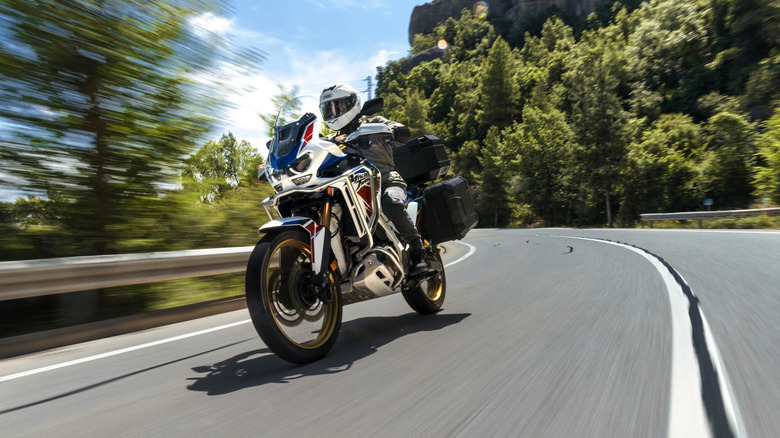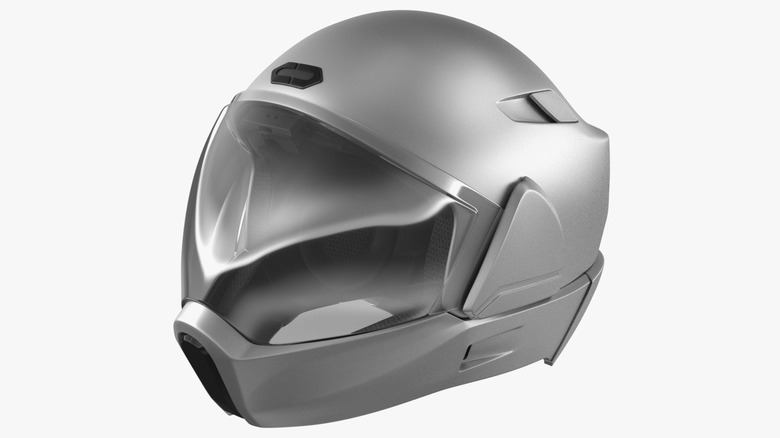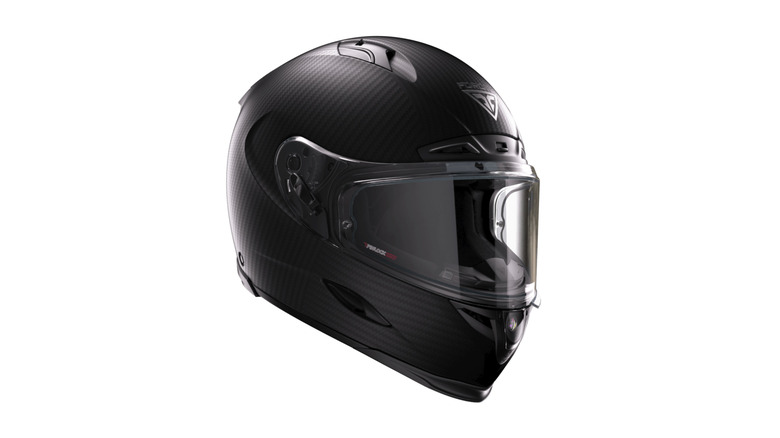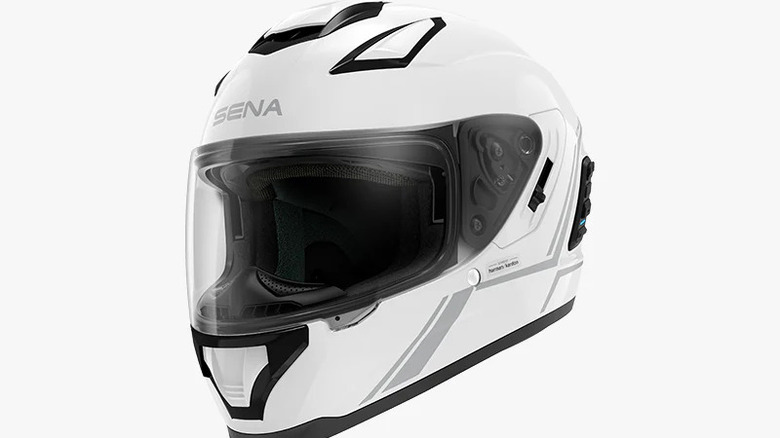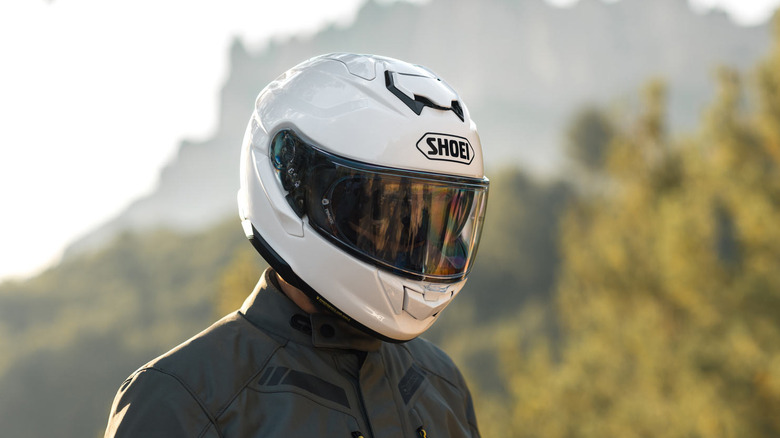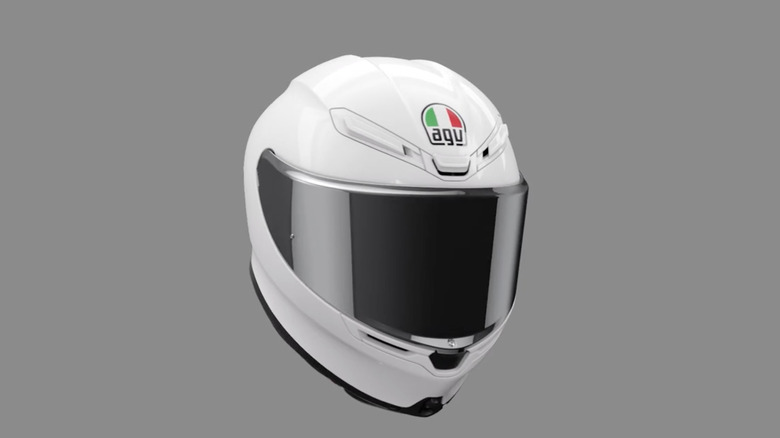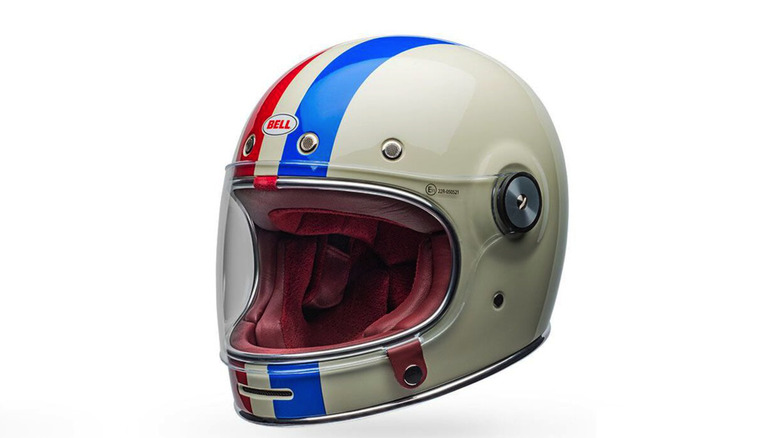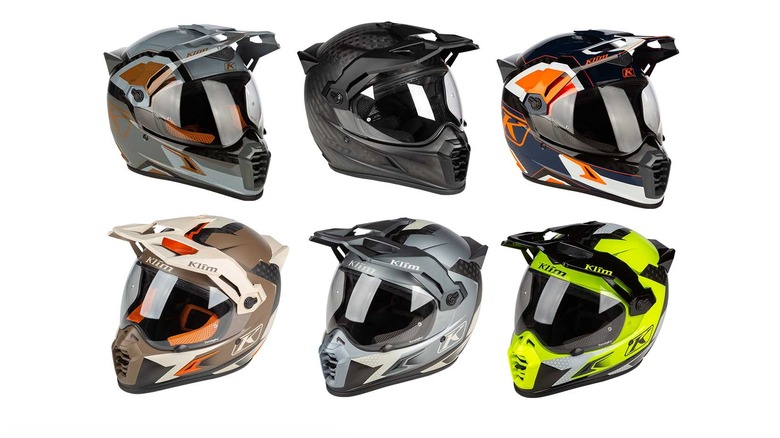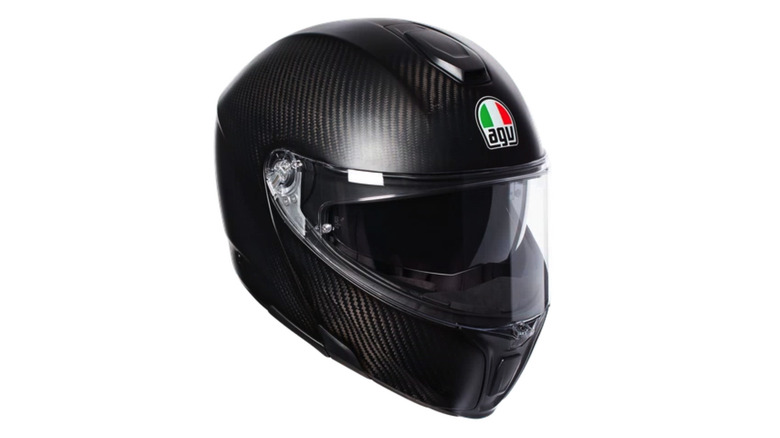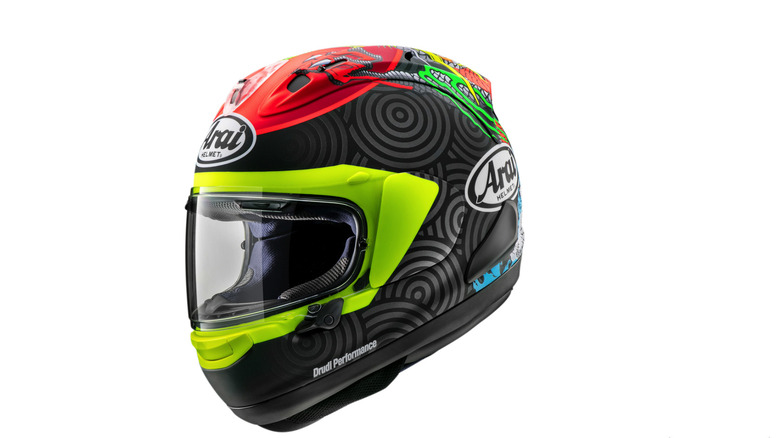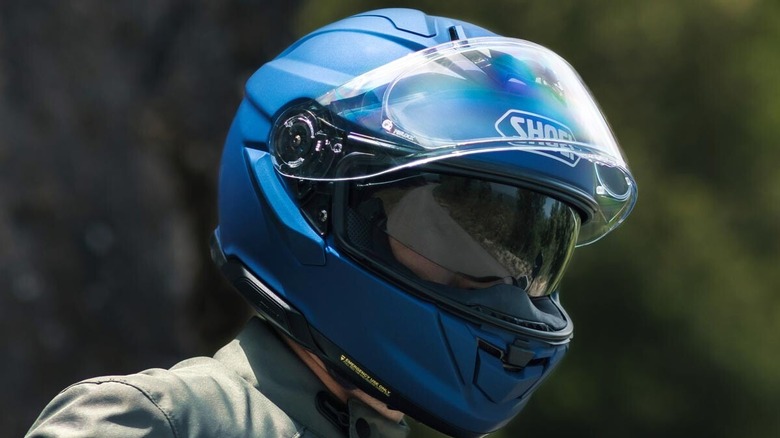10 Of The Best Full-Face Motorcycle Helmets In 2024
Choosing your ideal motorcycle helmet can be a challenging proposition that, for bikers, is often only secondary to choosing your perfect motorcycle. Many options are available to suit various applications, with a slew of features and benefits even before you figure out whether it suits your unique head shape and size. However, all motorcycle authorities agree that a full-face motorcycle helmet is considerably safer than an open-face or half-helmet, as it protects the face and jaw from frontal impacts.
As the last line of defense between your noggin and the world around you, a helmet is the most important item of protective motorcycle gear. When buying, you must dedicate enough consideration to ensure that your chosen brain bucket is a good physical fit and well-suited to your requirements. According to several leading brands, a helmet should be replaced every five years. While it's certainly in their best interests to suggest it, this rule of thumb should be adhered to, as all suffer knocks and scrapes over their lifetime, and stress and general degradation markedly deplete a helmet's structural integrity.
If you are a first-time buyer or it is time to replace your existing motorcycle helmet, SlashGear is here to help. The following full-face helmets cover various applications, including dirt riding, touring, motorsports, and adventure biking, with classic and contemporary styling and smart features on several models. Modular helmets are included here, as they offer the same protection as full-face helmets, provided they are used correctly.
CrossHelmet X1
Motorcycle helmets are yet another product that has started to incorporate smart technology. While most of us agree that smart toasters and smart toilets have little real-world value, bike helmets are one device where smart tech has both practical and safety benefits that could be considered essential. Following a Kickstarter fundraiser in 2022, the CrossHelmet X1 has come to fruition as an innovative smart helmet with aesthetics and features, shining a light on where the premium helmet industry is headed.
The CrossHelmet X1 comes with built-in Bluetooth technology, not as an optional extra or as a stick-on module that protrudes from the jawline. Many of us are well-acquainted with the benefits of smart helmet tech when taking phone calls, listening to navigation prompts, and using in-helmet entertainment. However, installation can be fiddly, earpieces uncomfortable, and wires can be pinched and stretched with repeated use.
The CrossHelmet X1 circumvents these issues by being built for purpose, and one area where it shines is its noise-cancellation properties. It ably filters out excess ambient noise from wind, traffic, and engines, leaving you in relatively quiet composure or immersed in your choice of audio. In addition, it adheres to high levels of comfort and safety and offers excellent visibility on either side.
The sci-fi aesthetic might not be everyone's cup of tea, but it's hard to fault regarding build quality and features.
Forcite MK1S
If the CrossHelmet X1 is considered cutting-edge, Forcite kicks it up with its MK1S, which adds visual prompts to its smart helmet. This could be a watershed moment for high-end helmets, as other brands like EyeLights are already making waves with HUD (head-up display) technology within a rider's peripheral vision.
The Forcite MK1S features an LCD in the rider's visor space that relays alerts and navigation cues without them averting their eyes from the road ahead. It would be subjective whether this could be considered a genuine substitute for its dashboard equivalent. Still, HUD displays have already proved their value in Formula One racing, and the amount of interaction can be tailored to your preferences via the Forcite companion app. Additionally, there is a wireless Bluetooth controller to adjust settings on the fly and a chin-mounted camera to record your rides, with low-light capabilities and a super-wide lens.
Forcite claims that the MK1S is the most advanced helmet available and is certainly impressive. However, it lacks a Bluetooth/Mesh communication system, a critical component in smart helmets, and one that many would consider more valuable than many of the MK1S's abundant features. It is also only DOT certified, with no ECE or Snell rating, which some may consider insufficient, especially for a unit costing around $1,100.
Sena Stryker
Many of us will be familiar with Sena, a leading motorcycle communication system manufacturer. Lately, the brand has progressed to making entire smart helmets, and the results are impressive. The Stryker is a recent addition to Sena's helmet lineup; expectedly, it incorporates its class-leading onboard comms, among other features.
The Stryker boasts mesh and Bluetooth intercom connectivity that has a range of 1.2 miles, with US-based audio experts Harmon Kardon providing speaker and microphone technology for a premium, immersive experience. Ventilation is comprehensive, with seven vents, keeping you cooler when the anti-fog visor is down. There is a retractable sunshield, which is a reasonably common feature nowadays, and it also has a built-in tail light, which is a novelty. However, it will affect battery life if used extensively.
Intercom control buttons are often fiddly, and they are situated a little far to the rear of the helmet and are pretty flush with its profile, which might take a little getting used to. Colorways are also limited to black and white, which is a little disappointing. However, the Sena Stryker is good value at around $400 for a smart helmet that is DOT and ECE-certified and comes ready to ride with valuable features that would otherwise considerably bump up the price as additional accessories.
Shoei GT Air 3
The last time I was in the market for a replacement helmet, I conducted due research and settled on the Shoei GT Air II. As such, I can attest to its excellent aerodynamic and ventilation properties, and the built-in (optional) Sena comms were the icing on the cake. The Shoei GT Air 3 is the latest generation in the class-leading touring helmet lineage. While it is undoubtedly an improvement on its older siblings, it sticks to the same principles without looking like a complete reworking of this tried and true favorite.
For the GT Air 3, the Japanese brand opted for a profile similar to that of the Air II, and it takes a close comparison to see any discernible difference. One feature that does stand out is its more subtle communication panels on either side. These are more in line with the contours of the helmet's rim and are, therefore, less intrusive, although whether the smaller buttons are as easy to operate with gloves on is another matter.
Thankfully, Shoei adopted an if-it-ain't-broke-don't-fix-it approach to many of the helmet's other features, including the excellent ventilation from which it gets its name, the integrated sun shield, and the Pinlock-ready visor. The dedicated Comms system, also optional, is the latest Sena SRL3, which is excellent, but buyers beware, as it is not universally compatible with other brands. However, Sena's main competitor, Cardo, has rectified Cardo-Sena Mesh connectivity in its latest updates if most of your biking friends have Cardo systems.
AGV K6 S
Leading Italian manufacturer AGV, makes helmets for all applications. While many of the helmets listed here are keen to attract attention with their features and accessories, AGV has chosen to focus on the most crucial aspect of helmet usage with its K6 S model, and that is safety. It has a standard aesthetic that is well-suited to touring and racing alike. Still, it comprises high-spec materials and an ultra-lightweight design gleaned from the brand's experience making helmets for MotoGP.
At just over 1.2 kilograms, AGV claims that the K6 S is one the lightest road helmets ever made, and it has excellent aerodynamic properties that make it even more comfortable against wind resistance. Airflow was also a key consideration when designing the K6 S, and there are five vents situated to gather as much air as possible and direct it around the head from the visor to the spoiler. It is available in four sizes, so you stand a good chance of finding the perfect fit, and it is both DOT and ECE 22.06 certified despite its relatively low weight.
The AGV K6 S would make the perfect helmet for the motorcycling purist who wants to get out and ride without the added fuss and expense of smart features and other accessories. Even the strap is a simple tried-and-trusted double D-ring with a snap button, and there is no sun shield, although the lack of a side lever leaves the helmet looking clean and uncluttered. Whether you have a cruiser or a fully-fared sportbike, the K6 S will look well suited as one of the most versatile helmets produced by this premium brand.
Bell Bullitt
Anyone with more than a passing interest in motorcycles will know there has been a massive resurgence in modern classics since the turn of the century. This Renaissance is primarily thanks to brands like Royal Enfield and BSA, with modern retro models combining classic styling with affordability and fun performance. However, if you're going for a classic image, you need a helmet to match, and Bell has just the solution with its Bullitt model.
The veteran brand has created a model with a timeless design and up-to-date levels of protection. Based on Bell's "Star" model, which was popular in the mid-20th century, it exudes quality from its range of slick, customizable graphics and colorways to its premium materials, including composite fiberglass and leather. A range of visors with different tints and bubble profiles are available, and the helmet features a chin intake with exhaust vents for improved airflow.
The Bell Bullitt is a solid choice for anyone with a retro-style cruiser or cafe, whether a Bonneville, Z 900RS, or Continental GT. Suppose you're concerned about compatibility with modern tech. In that case, it includes speaker cutouts, so you can attach your choice of comms unit without a fuss and enjoy all the benefits without harming your retro image.
Klim Krios Pro
In stark contrast to the Bell Bullitt is the Klim Krios Pro. Explicitly made for the ADV market, adventure riders would appreciate the lightweight carbon fiber construction and advanced ventilation of this DOT/ECE-certified helmet that comprises modern looks and features.
The Krios Pro's inner lining is made of Koroyd, a material developed for the aerospace industry. It consists of thousands of tiny tubes fused to create a strong yet light interior that absorbs and distributes pressure away from impacts. Being around 95% air, it also helps in ventilation, keeping riders cooler as they venture off the beaten track and tackle rugged terrain.
The Krios Pro can be switched between four "ride modes," depending on your requirements. These include an ADV mode and street mode with a visor and off-road and dual-sport modes with goggles, making this a versatile choice if you favor more than one riding style. It also has one of the most prominent air intakes we've seen on the chin, and, as you might expect from a helmet of this caliber, it is fully compatible with the Sena 10U and other comms systems.
Shoei VFX EVO
Another model from this premium Japanese brand, the Shoei VFX EVO, is designed for off-road enthusiasts and motocross. It has excellent airflow qualities and advanced aerodynamics and is notable for its highly sculpted profile, protruding peak, and chin guard, distinguishing it from touring and sportbike helmets.
The VFX EVO was designed with ventilation in mind, as motorsports can be highly demanding, and fatigue can set in quickly. It has multiple front vents and rear ports to keep a constant airflow around the head without sacrificing its strength, and its multi-shell construction incorporates Shoei's Motion Energy Distribution System, which reduces the force of impacts on the head.
Another safety feature of the VFX EVO is the brand's emergency quick-release system, which is included on many Shoei helmets. In the event of an accident, an emergency responder can pull on two tabs to remove the cheek pads. This means they can easily slide the helmet off without exerting too much force on the neck before attending to the rider, making it a good choice for off-roading, where spills can be frequent.
dddddddddddddddddddddIt is also available in many solid colors with three tasteful graphics to ensure the wearer stands out when using it in competition.
AGV Sportmodular Carbon
The AGV Sportmodular Carbon is a prime example of the quality this brand produces. It is among the strongest and lightest helmets available, built almost entirely from carbon fiber. As a nice touch, the material's weave is visible on the shell, adding to its premium appeal.
The AGV Sportmodular Carbon looks unremarkable from a distance, but this couldn't be further from reality. As the name suggests, this is a modular helmet with a flip-up chin guard, which adds an extra practicality element when stationary or performing low-speed maneuvers. However, it is always advised that you wear the chin guard locked in position when underway.
Other features include a wind-tunnel-tested aerodynamic profile, communication system compatibility, and premium fabrics and cushioning materials to ensure the best possible comfort and fit. A Pinlock visor insert is included for anti-fogging, and it offers 190 degrees of horizontal visibility, making this a very unobtrusive option, especially when considering its weight of under 1.4 kilograms.
However, one of the most impressive features of the AGV Sportmodular Carbon is its value. It is in a similar price range to many high-end helmets despite being an ECE/DOT-approved model that is predominantly carbon fiber, a notably expensive material.
Arai Corsair-X
Arai is a significant player in the helmet industry, and the Corsair-X is one of its most versatile models. It is available in various colorways and graphics and has advanced safety characteristics. While it doesn't boast as many bells and whistles as many models listed here, it is a premium helmet that focuses on its primary objective: to provide optimal levels of safety and comfort.
At well over $1,000, the Arai Corsair-X is undeniably expensive, but if you go all-in on one item of safety gear, it should be a helmet. For this, you get some of the best build quality in the industry, with special Super Fiber construction and materials gleaned from Formula One engineering. Protection is top-notch, with much research and development focused on direct impacts and glancing blows by redirecting energy around the helmet rather than absorbing it.
While the Corsair-X may not be loaded with accessories, it is no less impressive. Bespoke air diffusers channel air for ventilation and improve aerodynamics, and proprietary interior liners are equipped to wick away moisture. The chin curtain creates a seal that directs air to the exhaust vents, making the helmet as comfortable as it is lightweight. Additionally, there's a special "variable axis system" on the Pinlock-equipped visor that smoothly pivots and stays in position while a visor latch locks it closed.
How we made our choices
We chose to discuss full-face helmets here, as these provide the best protection and are, therefore, more worthy of recommendation. All are certified by DOT, with most also carrying Snell and ECE certifications. We have made sure to include most major brands and a variety of budgets. When deciding on the ten best motorcycle helmets in 2024, our metrics included comfort (including weight and ventilation), features, aesthetics, and value.
We also used information from safety authorities, including the NHTSA, and trusted reviews from online publications, including WebBikeWorld, Revzilla, and Motorcycle News.
